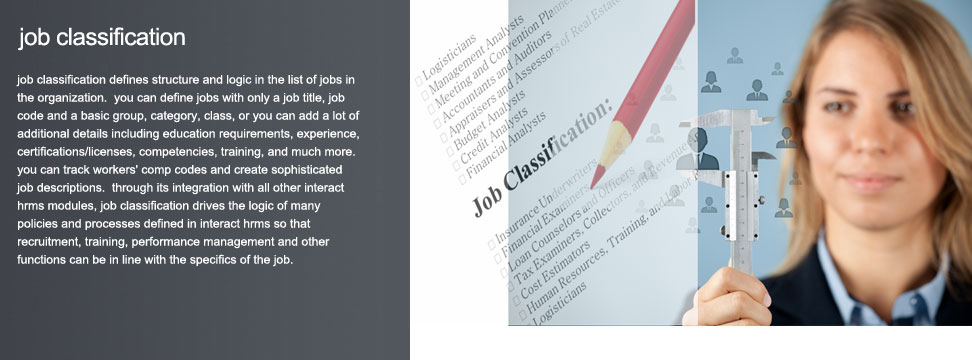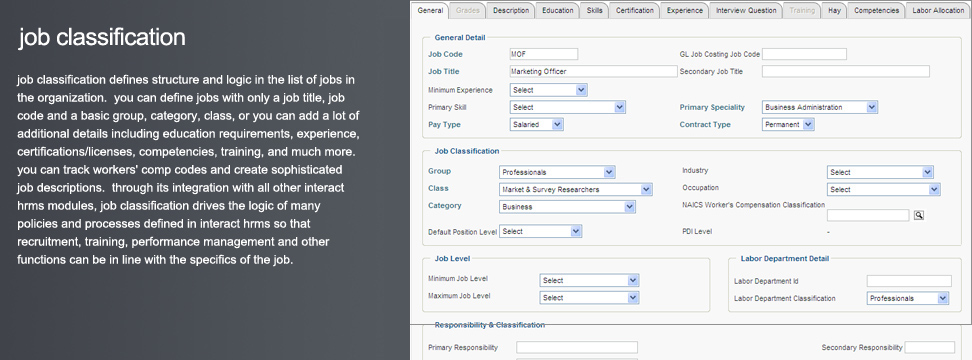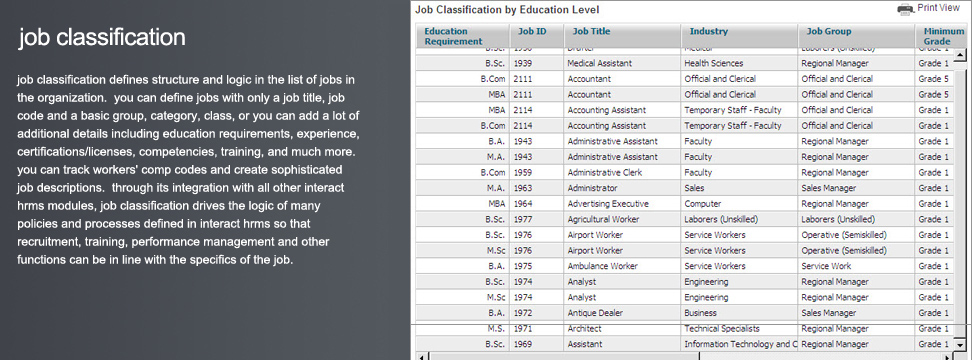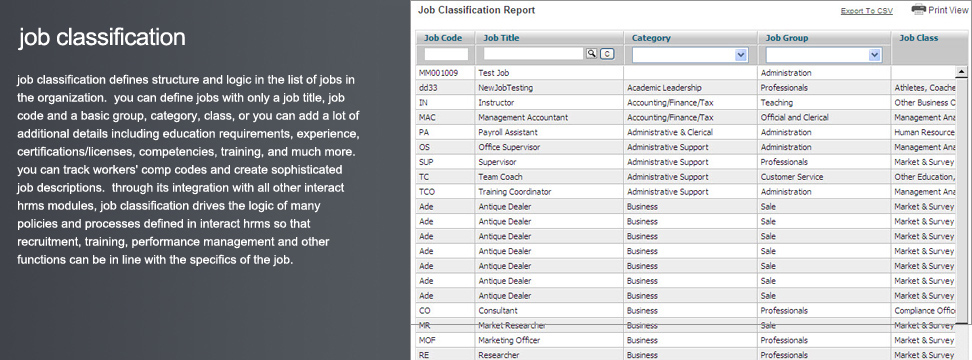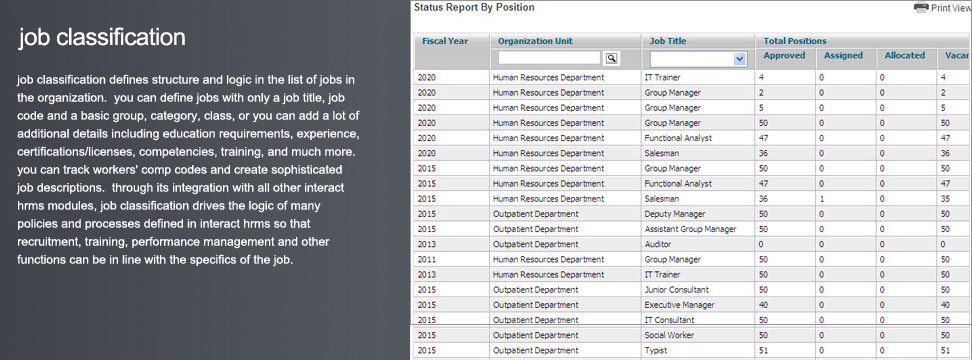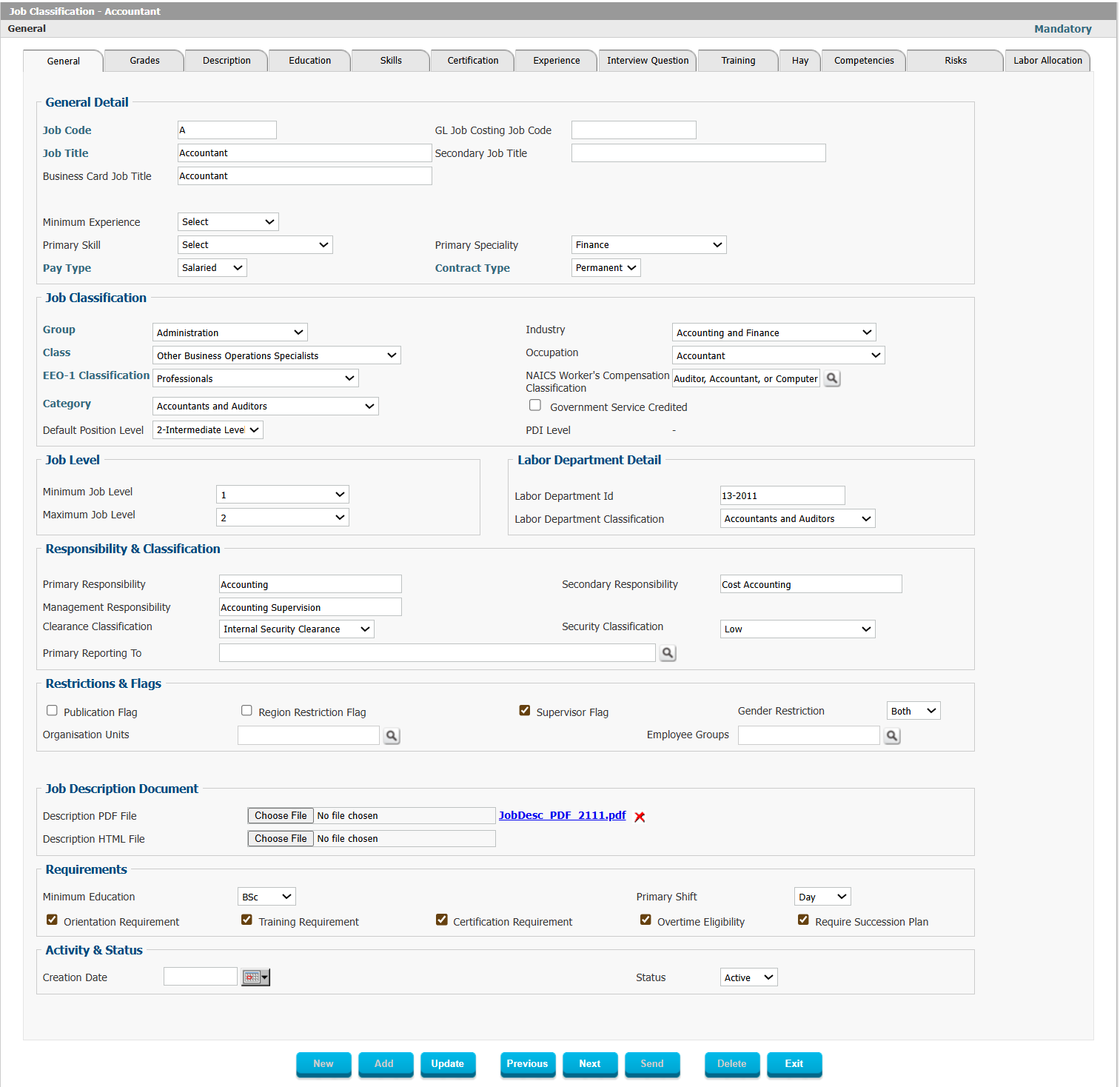Figure 1: Job Classification
The Job Classification module in Interact HRMS is a comprehensive system that supports the organization’s approach to defining, managing, and evaluating job roles. By offering both Grade and Point Classification Systems and supporting an extensive range of job attributes, this module helps organizations standardize job descriptions, define salary grades, outline qualifications, and create competencies required for each role. Through the creation of a Job Catalogue, this module ensures that all job-related information and associated rules are systematically applied across HR functions, supporting consistent job management, budgeting, and recruitment processes.
This module is ideal for organizations looking to establish structured job definitions, support budget planning, and ensure consistency in role requirements. By centralizing job information, the Job Classification module enables efficient talent management, aligns with organizational standards, and provides an easily accessible job reference across the entire HRMS system.
General Job Definition with Flexible Attributes
The Job Classification module enables organizations to define each job in detail, covering attributes like Job Title, Industry, Specialty, Grade and Step Classification, and Minimum and Maximum Salary Ranges. Each job can be categorized based on Job Group, Class, Category, Industry, Occupation, or Workers’ Compensation Classification to ensure comprehensive job descriptions that meet operational and regulatory needs.
For example, a software engineer role may be classified under the technology category, with specific salary ranges and skill requirements. This structured approach supports consistency in job definitions, enabling the organization to create clear, comprehensive job profiles.
Detailed Education, Skills, and Experience Requirements
The module allows organizations to outline Education Requirements, Skills, and Experience Levels needed for each job role. Users can define multiple education levels, specific skills, and years of experience, ensuring that job profiles reflect the qualifications required to perform the job effectively.
For instance, a management position might require an MBA, specific leadership skills, and five years of experience. By documenting these qualifications, the module provides a clear reference for recruitment and performance assessment, supporting accurate candidate evaluation.
Certification and Training Requirements
The Job Classification module enables organizations to specify any Certifications or Training Courses required for each job. This functionality ensures that roles are defined with the necessary certifications and that training needs are documented, supporting both compliance and skill development.
For example, a healthcare role might require certifications in patient care and CPR training. By defining these requirements, the organization ensures that only qualified candidates are considered, supporting regulatory compliance and high performance in specialized roles.
Hay Method Job Evaluation and Competency Requirements
The module includes support for Hay-Method Job Evaluation, allowing organizations to assess roles based on the competencies and responsibilities required. By outlining the Competencies necessary for each job, the module ensures that positions are evaluated fairly and consistently, supporting structured job evaluation processes.
For example, a senior engineering role might require competencies in problem-solving, technical knowledge, and project management. These evaluations provide a clear benchmark for job performance, compensation, and talent development, ensuring that job roles align with organizational standards.
Comprehensive Job Descriptions and Responsibility Definitions
Each job in the Job Classification module includes a Detailed Job Description, which can be typed directly or uploaded, covering Primary and Secondary Responsibilities of the role. This feature provides a clear outline of job expectations, supporting recruitment, performance evaluation, and talent development.
For instance, a job description for a customer service manager might include responsibilities such as team management and customer satisfaction metrics. This detailed approach ensures that expectations are clearly documented and communicated to both HR and employees.
Enterprise-Wide Job Catalogue with Automatic Inheritance
The module allows for the creation of an Enterprise-Wide Job Catalogue that standardizes job roles across the organization. Once the Job Catalogue is defined, it is automatically inherited by all Interact HRMS applications, ensuring consistency in job data across HR functions such as recruitment, performance management, and payroll.
For example, once a job profile for “Financial Analyst” is created, it can be accessed by various departments for recruitment or performance evaluation, supporting standardized processes. This centralized job catalogue enables easy access to job information and ensures alignment across HR activities.
Separate Job Catalogue for Each Employer and Multilingual Support
Organizations with multiple employers or locations can maintain Separate Job Catalogues for each entity, allowing for tailored job definitions. Additionally, the Job Catalogue supports Multilingual Definitions, making it accessible to a diverse workforce and supporting global operations.
For instance, a multinational company can create job descriptions in multiple languages to accommodate employees in various regions. This flexibility supports localization and ensures that job definitions are accessible to employees regardless of location or language preference.
Job Classification Search and Viewer for Easy Selection
The Job Classification module provides a Viewer and Granular Search tool that enables users to locate job classifications quickly when they need to assign roles, create contracts, or manage other HR functions. Users can select job roles easily from a searchable list, streamlining the process of finding and assigning specific job profiles.
For example, during the hiring process, an HR representative can quickly locate the “Sales Manager” role by searching within the viewer, saving time and ensuring accuracy. This functionality supports efficient HR operations and reduces the time spent on job classification.
Workflow-Linked Job Classification Review and Approvals
Job classification reviews and approvals are managed through a Workflow Process, allowing all necessary reviews and approvals to be completed within the system. This feature ensures that any changes or additions to the job catalogue are properly reviewed and approved by relevant stakeholders before they are implemented.
For example, if a new job role is added, it must be reviewed and approved by the department head and HR director, ensuring compliance with organizational standards. This structured workflow enhances accountability and maintains control over job classification updates.
Activation and Inactivation of Job Roles
The module includes options for Activation and Inactivation of job roles, allowing organizations to deactivate roles that are no longer in use. Inactive roles remain in the system for historical reference and can be reactivated if needed, supporting flexible job management.
For example, a seasonal role like “Summer Camp Instructor” can be inactivated after the season ends and reactivated the following year. This functionality ensures that job data remains relevant and supports organizational needs as roles change over time.
Attributes for Budgeting, Grade, and Salary Information
The Job Classification module includes fields for Budgeting, Grade, and Salary Information, supporting financial planning and salary administration. Minimum and maximum salary ranges, grade levels, and budgeting information are specified for each job, ensuring that compensation aligns with organizational standards and budgetary constraints.
For instance, an HR team can reference the salary range for “Project Manager” when budgeting for new hires, ensuring that compensation remains within approved ranges. This integration with budgeting supports financial control and helps the organization allocate resources effectively.
General Features of the Job Classification Module
- General Job Definition: Define job title, categories, industry, grade, step classification, and salary ranges.
- Education and Skills Requirements: Specify multiple education levels, skills, and experience needed for each job.
- Certification and Training Needs: Outline required certifications and training courses to support compliance.
- Job Description and Responsibilities: Include detailed primary and secondary responsibilities to clarify role expectations.
- Competency Requirements: Define competencies needed for each role, supporting structured evaluations.
- Job Catalogue for Enterprise and Employer: Create and manage a comprehensive job catalogue at the enterprise level with tailored catalogues for each employer.
- Multilingual Job Catalogue: Support global operations with job definitions in multiple languages.
- Workflow for Classification Review: Use structured workflows for job classification review and approval.
- Activation and Inactivation: Manage job role statuses to keep job data current and relevant.
- Budgeting and Grade Information: Include budgeting, salary range, and grade information for financial planning.
Summary: Interact HRMS Job Classification Module
The Interact HRMS Job Classification module provides a structured and comprehensive approach to managing job roles and classifications. Key benefits include:
- Detailed Job Definition and Categorization: Define jobs with detailed information on title, salary range, grade, industry, and category.
- Education, Skills, and Certification Requirements: Specify qualifications and skills for accurate candidate evaluation.
- Hay Method Job Evaluation and Competency Definition: Use structured evaluation methods and competencies to assess roles.
- Comprehensive Job Catalogue: Create a centralized job catalogue for consistent access to job profiles across HR functions.
- Separate Employer Catalogues and Multilingual Support: Manage catalogues for multiple employers with support for various languages.
- Integrated Search and Viewer: Easily locate and assign job roles with a viewer and granular search tool.
- Workflow-Based Review and Approval: Ensure all job classifications are reviewed and approved through structured workflows.
- Job Activation and Inactivation: Manage the status of job roles to keep data relevant.
- Attributes for Budgeting and Grade Management: Include budgeting and grade information to support financial planning.
- Seamless Integration Across HR Functions: Ensure all job data is accessible across HRMS applications, supporting recruitment, performance, and payroll.
By combining these features, the Job Classification module enables organizations to establish a structured job framework that supports accurate recruitment, budgeting, performance management, and compliance. This structured approach to job classification enhances operational efficiency, aligns with organizational standards, and provides a clear foundation for managing workforce requirements across departments and locations.

